Create a Japanese corner
• Create a scenery with pots
• Growing plants in unusual containers
• Make your potted plants more beautiful
• Choose the material of pots
• Look after your pots to make them last
• The right pot for the right plant
• Upright-growing plants in pot
• Growing a tree in a pot
• Hiding a cumbersome stump
• Hiding the compost heap
• Optimize Trees
• How to redesign a flowerbed ?
• Create a flowering border like a painter
• Harmonise foliage between them
• Succeed with your borders
• An attractive garden in winter
• Create a Mediterranean corner
• Create an exotic area
• Create a Japanese corner
• Create a green roof
• Create a rockery
• An Acer, for all gardens
Recommended products for Japanese Garden
Are you feeling like having an Eastern atmosphere in your garden, a serene spot in all seasons? The fitting out of space in the Japanese-style is right for you. It is not complicated as the bases are really simple.
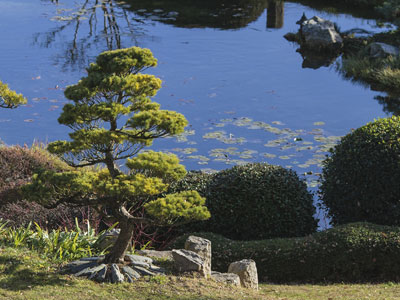
The garden of a master of Japanese-style gardens, Erik Borja: all in silhouettes.
First of all, isolate the space
The art of Japanese-gardens can be expressed in all circumstances, whether the spot is surrounded by screening walls or giving onto an open space. But it is easier to close the chosen space to be fitted out, especially if the surrounding area is fairly attractive or because you want to create a 'bubble' in which you wish to isolate yourself. Choose preferably light walls like screening walls, garden-screens, heath screens or reeds-screens well fastened so that the wind does not tear them off. Bamboo's' stakes are useful to keep the different elements into place.
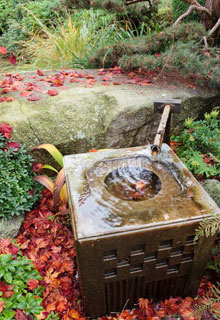
The fountain can be more or less ornate (Japanese garden of Havre's harbour).
Draw it
Depending on the available space, you can include a lot or very little elements. On a few square meters, you only need a lantern or a statue and small Bamboos. In a larger space (more than 100m2) you can consider a pond, a reading place or a meditating spot. Traditionally, the entrance in a Japanese garden is done by a low portico which incites you to humbleness. Then straight away you find a fountain which symbolizes the spirit's purification. Start by drawing the pathways, 60 cm wide, depending on the route, which must be winding. The setting up of the rest of the available space (a sitting area, a Japanese lantern, plants, focal points...) then comes naturally, depending on your wishes.
Choosing the plants
The plants in a Japanese garden have often green leaves all year round (evergreen plants) as the area is visited throughout the entire year, to enjoy what each season has to offer. Dwarf Bamboos, Heavenly Bamboos (Nandina), Sedges (Carex), Japanese Forest Grass, Rhododendrons... Japanese Maples and the Dwarf Cherry tree Kojo-no-mai are unavoidable even in the smallest of areas. If you have space, include some deciduous shrubs and trees such as a Corylus contorta, a Prunus mume or a Japanese-Quince tree which all are excellent choices. Place them leaving a space around each of them so as to enhance their silhouette. Separate them with ground-covering plants like Cotoneasters, Festucas, Ophiopogon Japonicus (Mondo grass)...Moss found in woods is tempting, but it is not always allowed to remove some and it doesn't take easily in a garden. Think also to include plants which can be pruned in stone's shapes (Box, Holly, Phillyrea Latifolia...).
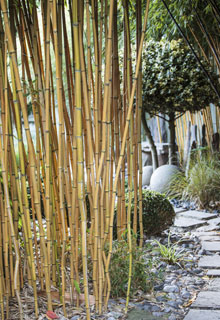
The Bamboo and the Ophiopogon Japonicus are two unavoidable plants.
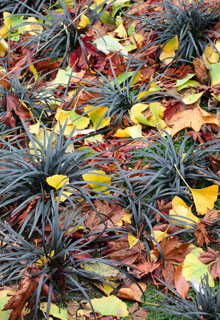
The Bamboo and the Ophiopogon Japonicus are two unavoidable plants.
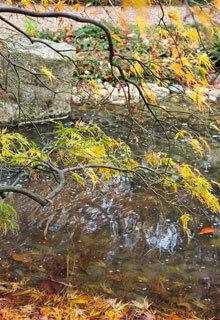
A Japanese Maple is perfect near water.
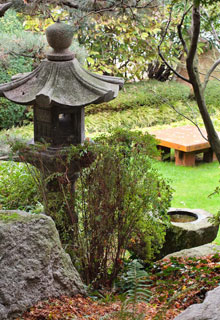
A Japanese lantern is always admired, especially when given a patina! (Japanese garden of Havre's harbour).
The mineral, half of the success
Elements made in stone are really important in a Japanese-style garden as they symbolize the nature which is inanimate. Pebbles, decorative pebbles, Japanese steps, a stretch of sand must therefore be integrated in the space. To keep the mineral stretches clean, you can place some geotextile underneath to limit weeding. Bann lines, even numbers and sharp angles. But do not skimp on quantities: stone count as much as plants in a Japanese garden!















































































































































































































































